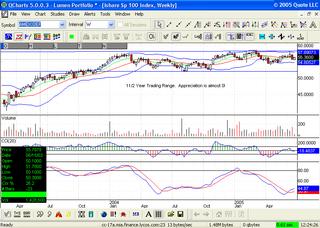Remember we recently listed the rising prices of homes as an NBBT (The Next Big Bad Thing). Here as best I can figure are the two things that concern the experts. 1. People are using their homes as a piggy bank, refinancing out their rising equity for personal use. This is supposed to be a bad thing. It is supposed to be bad because at some point when prices stagnate or quit going up the homeowner will be faced with either less equity or at the very least will not be able to continue going to the home banking well. Also the homeowner will have built up no equity over time in this scenario. 2. The combination of rapid appreciation in home prices plus the access to easy credit has led to a financial bubble in housing that in the eyes of many financial gurus is unsustainable.
Let’s take the 2nd of these issues first and on the onset let’s also stipulate that I’m no expert on real estate. That being said, I don’t doubt that you can look at parts of the country and find overheated aspects of housing. And I also don’t doubt that at some point the music will stop for those people that I constantly hear about on TV who are flipping condos that haven’t been built yet. But I don’t know if the music stops tomorrow or next year. I also probably won’t know at the end whether these flippers will have done it enough so that in the aggregate they will have made money. I do know that when the "bubble bursts", the press will only tell us about the unlucky Joes who went down in flames.
One of my early mentors used to say "it's a big country" when he'd see some generalization about issues like housing in the press. Well it is a big country! A lot of people live in its middle and an awful lot of that property hasn’t experienced the kind of growth seen on the coasts or in places like Las Vegas. My guess is that housing five miles inland from Miami Beach hasn't seen the same kind of appreciation either. Or take my home town of Union City. I doubt that there are more than two houses there that would sell at a price north of $200,000. Some digging on the web well tell you that the median home price in a place like Lafayette Indiana is currently about $204,000*. Now that is still up 15% in the last 12 months but hardly seems to be the kind of runaway pricing I’m constantly hearing about.
Now about those people using their homes as a piggy bank. Let’s start off by saying that the family who refinances every 2 years so they can go to Disneyworld or go on some sort of preternatural shopping spree is not doing a good thing in the long run. Everybody knows somebody like this. They also happen to probably know the family that refinances to put a child through college, pay off bills or remodel their homes which generally has the effect of adding to its value. At the end of the day it’s going to depend on why people are taking the money out. Each case is different.
Finally let’s look at the appreciation of housing and do some math. Let’s use Lafayette, Indiana again. Let’s say that the fellow that owns that home worth the median price bought it 8 years ago for $100,000, putting $30,000 down. 4 years ago with his house worth $140,000 he refinanced, taking $35,000 out. $25,000 went into some remodeling and $10,000 paid off some bills. This year with his house basically worth $204,000 he is refinancing again. He wants $20,000 for college tuition. What irrational choice has this gentleman made? Especially since equity interest rates are currently lower than most other forms of credit and the interest is potentially tax deductible.
As for appreciation (the same home using only one refinance and we’ll say for fun that his return on the $35,000 he originally took out has helped his appreciation on a 1-1 basis). Note: I'm trying to keep this simple so there are things like his income and the effects of property taxes I'm leaving out.
$204,000
-$100,000 Purchase Price
- $35,000 Refinance
- $8,000 ($1,000 x 8 years annual maintenance on the home.)
$61,000 is his profit.
On average the house has appreciated a little better than 7½% a year. Not a bad return (and I do understand that the leverage from his mortgage has made his personal return higher), but not shoot the lights out money.
We’ll discuss the investment implications of this soon.
*Source: realtytimes.com ,June 17, 2005. The actual median price is $203,800.
 I've started to experiment putting charts in this blog so be patient during my growing pains.
I've started to experiment putting charts in this blog so be patient during my growing pains.